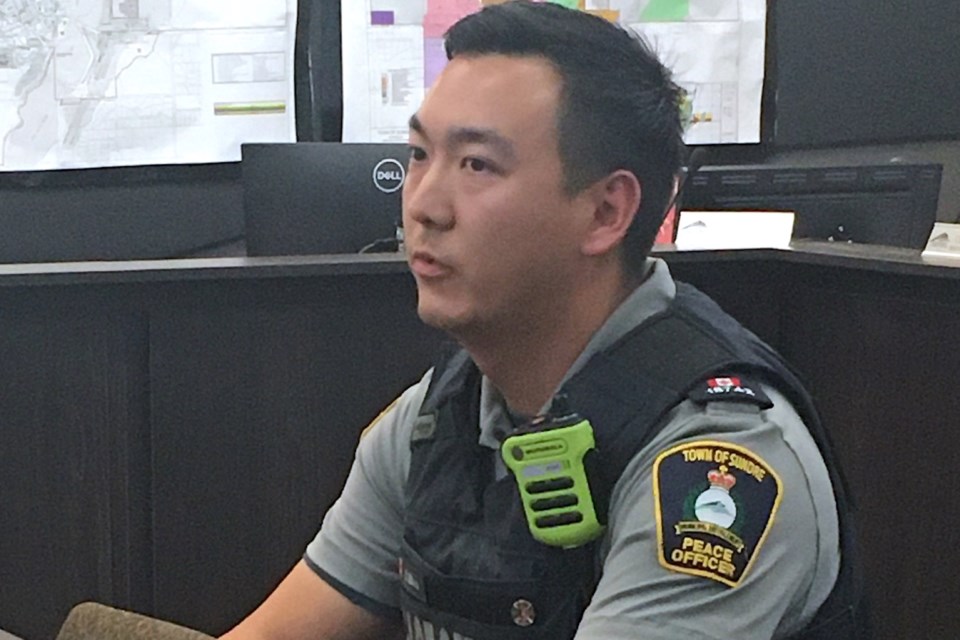SUNDRE – The number of motorists who drive eastbound along Highway 27 on the west side of town at excessive speeds represent a small percentage of the overall volume of traffic, council recently heard.
Community peace officer Sam Zhao presented to council on June 26 during the last regular meeting before summer hiatus the results of a statistical analysis from a study that was conducted over a period of 10 weeks from March 13 to May 21 on Highway 27 at 7th Street SW not far from the town office.
A traffic-tracking device was mounted onto a telephone pole to gauge the speeds of passing motorists in real-time, said Zhao.
The system does have limitations; primarily the need to be attached to an existing mount such as a utility pole as well as being installed with full exposure to sunlight as the device is solar powered, he said.
For example, it cannot be placed behind any obstructions such as a trees, and council would have to bear that in mind should the decision ever be made to move the device somewhere else, he said.
Proceeding to recap the breakdown of data, Zhao told council the busiest times of day from Monday to Thursday is between 4-5 p.m., and that peak traffic on Fridays is between 2-3 p.m., while on both days of the weekend the rush hour is generally around noon to 1 p.m.
Traffic substantially tapers off overnight, with the number of motorists travelling through Sundre between midnight and 1 a.m. ranging between about 80 to a little more than100 throughout the week.
“Over the course of these 10 weeks, a total of 190,000 cars drove by it,” he said. “The busiest times of the week is Monday through Friday.”
Providing further analysis of the data to help visualize how the flow of traffic on Highway 27 at 7th Street SW fluctuates depending on the given time and day, Zhao said that blue collar workers who are up early start getting on the road by about 4 a.m., when traffic begins to steadily increase until about 8 a.m. when other people make their way to work.
“There’s a lull after everybody gets to work,” he said, adding traffic eventually does get busier throughout the rest of the day until later in the afternoon.
“It peaks right after work around 4 o’clock and drastically decreases as people go home,” he said.
With regards to speeds, Zhao said some people have a tendency to focus on the outliers.
The peace officer also noted the traffic tracking device that collects the data does not differentiate between types of vehicles, and added the numbers of speeders is potentially skewed by emergency vehicles responding to calls.
The percentage of motorists going more than 70 kilometres per hour (kph) during a workday between 8 a.m. and 6 p.m. is “consistently one per cent,” he said.
The speed limit on that section of Highway 27 is 50 kph.
“The highest amount of cars going over 70 kilometres an hour is between 3 and 4 a.m. at seven per cent,” he said, adding the average throughout the whole day is about two per cent.
The overall average speed of motorists is about 52 kph while the 85th percentile – defined as the speed at or below which 85 percent of all vehicles are observed to travel under free-flowing conditions past a monitored point – is 59 kph, he said.
“When I look at those numbers, I don’t really interpret much of a problem on that street,” said Coun. Owen Petersen, asking if the peace officer arrived at the same conclusion.
“A lot of people like to call and say people are speeding. To me, speeding is relative. Speeding is going faster than the flow of traffic, and that depends on where you are,” Zhao said.
“It really depends on what you personally consider speeding to be,” he said.
Coun. Chris Vardas said most of the motorists in that 50 kph zone seem to drive just shy of 60 kph, or not even 10 kph over the posted limit.
“I really don’t find that as a speeding problem,” said Vardas, adding hardly anybody is up during the early morning hours when the number of speeders barely increases.
“I don’t think we have a problem on that road, personally,” he said. “But I do like the system we got there to be able to track it . . . it’s a good piece of equipment to have because this is data out of all the years that I was (previously) on council that we never, ever got to see.”
Coun. Jaime Marr asked if there might be plans to conduct additional studies on any other roads in town to better understand traffic trends throughout the community.
“Absolutely,” said Zhao, reminding council the device is limited only to being installed on a utility pole that is exposed to enough sunlight.
Council ended up accepting the peace officer’s report as information.



